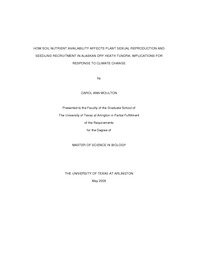
ATTENTION: The works hosted here are being migrated to a new repository that will consolidate resources, improve discoverability, and better show UTA's research impact on the global community. We will update authors as the migration progresses. Please see MavMatrix for more information.
Show simple item record
| dc.contributor.author | Moulton, Carol | en_US |
| dc.date.accessioned | 2009-09-16T18:18:21Z | |
| dc.date.available | 2009-09-16T18:18:21Z | |
| dc.date.issued | 2009-09-16T18:18:21Z | |
| dc.date.submitted | January 2009 | en_US |
| dc.identifier.other | DISS-10231 | en_US |
| dc.identifier.uri | http://hdl.handle.net/10106/1681 | |
| dc.description.abstract | The harsh growing conditions of the arctic biome, in particular low temperatures and soil nutrient availability, restrict the growth and reproduction of arctic plant species. Recent and ongoing changes in climate are increasing air and soil temperatures in these ecosystems, thus affecting decomposition rates of arctic soils. As decomposition increases, nutrients that are currently immobilized in the soil organic layer become available to nutrient-limited tundra plants. Plant species within the tundra communities then compete for the newly available nutrients, potentially causing a shift in community composition. As an important component of plant life cycles, seeds provide new individuals and genetic diversity to future adult communities, but little is known about the role that seeds play in arctic ecosystems where most species are also capable of producing new individuals vegetatively. My research focused on how experimentally adding soil nutrients for 12 years affected reproduction, seedling recruitment (dispersal and germination) and seedling establishment in dry heath plant communities in northern Alaska. Fertilizer addition significantly shifted adult community composition by decreasing lichens and evergreen shrub species and increasing abundance of the grass, Hierochloe alpina. Flowering and fruiting abundance also shifted among species with nutrient addition, reflecting the increase in H. alpina and a deciduous dwarf shrub, Betula nana, and the loss of lichens and dwarf evergreen shrubs in the adult community. Dispersal of seeds was greater with nutrient additions, particularly for B. nana, although dispersal of seeds within species, suggesting unequal distribution into the arctic landscape. Significant changes in species composition of germinated seed in soil seed banks occurred with greater nutrient availability, with the germinated seedlings reflecting the adult communities seen in the field. Few established seedlings were observed in both experimentally manipulated and control plots in the field, suggesting that recruitment from seed and subsequent seedling establishment is rare and most likely limited by space within the community. Certain plant species are better adapted to greater nutrient availability, thus resulting in the shift from an evergreen-dominated community to a grass-dominated community. Seeds from these species are continually being produced in current nutrient amended communities, and their role in maintaining that adult community may become important if disturbances, such as the removal of litter or adult vegetation by herbivores, occur. These disturbances may create conditions favorable for new seedling recruitment. Because higher soil nutrients favor different plant species, changes in plant communities in the Arctic could be greatly affected by climate change. | en_US |
| dc.description.sponsorship | Gough, Laura | en_US |
| dc.language.iso | EN | en_US |
| dc.publisher | Biology | en_US |
| dc.title | How Soil Nutrient Availability Affects Plant Sexual Reproduction And Seedling Recruitment In Alaskan Dry Heath Tundra: Implications For Response To Climate Change | en_US |
| dc.type | M.S. | en_US |
| dc.contributor.committeeChair | Gough, Laura | en_US |
| dc.degree.department | Biology | en_US |
| dc.degree.discipline | Biology | en_US |
| dc.degree.grantor | University of Texas at Arlington | en_US |
| dc.degree.level | masters | en_US |
| dc.degree.name | M.S. | en_US |
| dc.identifier.externalLink | http://www.uta.edu/ra/real/editprofile.php?onlyview=1&pid=83 | |
| dc.identifier.externalLinkDescription | Link to Research Profiles | |
Files in this item
- Name:
- Moulton_uta_2502M_10231.pdf
- Size:
- 1.156Mb
- Format:
- PDF
This item appears in the following Collection(s)
Show simple item record


